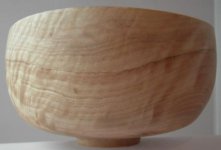Chriscb
Full Member
Afternoon all,
Well here's the thing. In October 17 my friendly tree chap drop off this huge example of a eucalyptus tree - the Tasmanian Cider Gum tree is one of the few that grow well in the UK. The big bits must be about 3 foot in diameter. I rough turned about 40 bowls, vases, platters and pots over about 3 weeks, set them all in shavings and large paper bags and waited. Long story short - I've only 8 pieces that haven't cracked completely, split, etc et al. Strange thing is the pen blanks I've cut all seem to be OK - turned one in January and it's not cracked. Just for completeness I've dried other woods without losing so many turnings.
So the question is - is my failure rate about average? Any tips as how to turn pieces and keep them whole? It's good to practice turning big bowls ( 5" x 20") but I'd really like to keep one - the grain is very good.
Thanks.
Regards,
Chriscb
Well here's the thing. In October 17 my friendly tree chap drop off this huge example of a eucalyptus tree - the Tasmanian Cider Gum tree is one of the few that grow well in the UK. The big bits must be about 3 foot in diameter. I rough turned about 40 bowls, vases, platters and pots over about 3 weeks, set them all in shavings and large paper bags and waited. Long story short - I've only 8 pieces that haven't cracked completely, split, etc et al. Strange thing is the pen blanks I've cut all seem to be OK - turned one in January and it's not cracked. Just for completeness I've dried other woods without losing so many turnings.
So the question is - is my failure rate about average? Any tips as how to turn pieces and keep them whole? It's good to practice turning big bowls ( 5" x 20") but I'd really like to keep one - the grain is very good.
Thanks.
Regards,
Chriscb



